Hungarian Lecsó Recipe
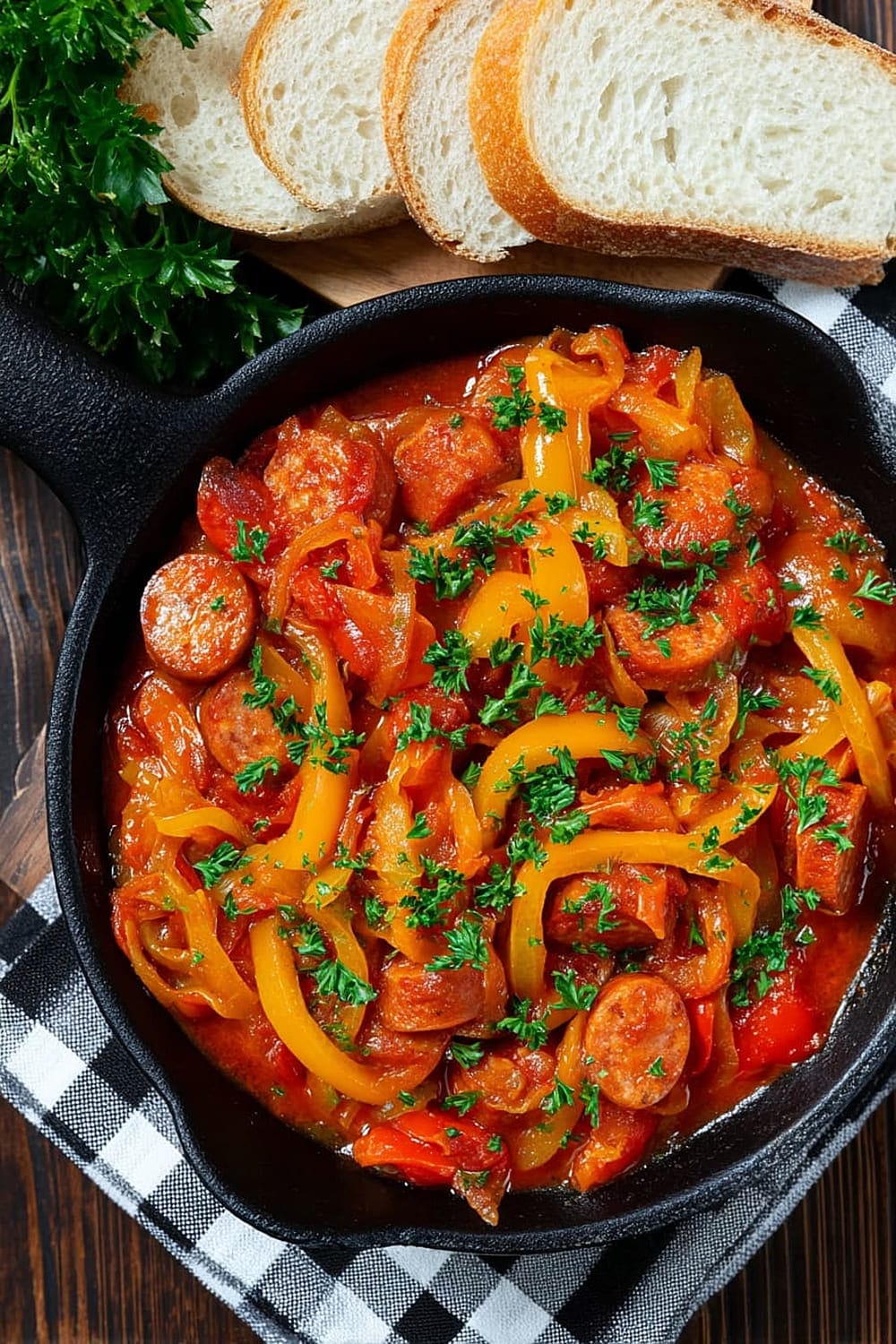
This Hungarian comfort food is basically the ultimate “I’m too tired to think but still want something amazing” dinner solution.
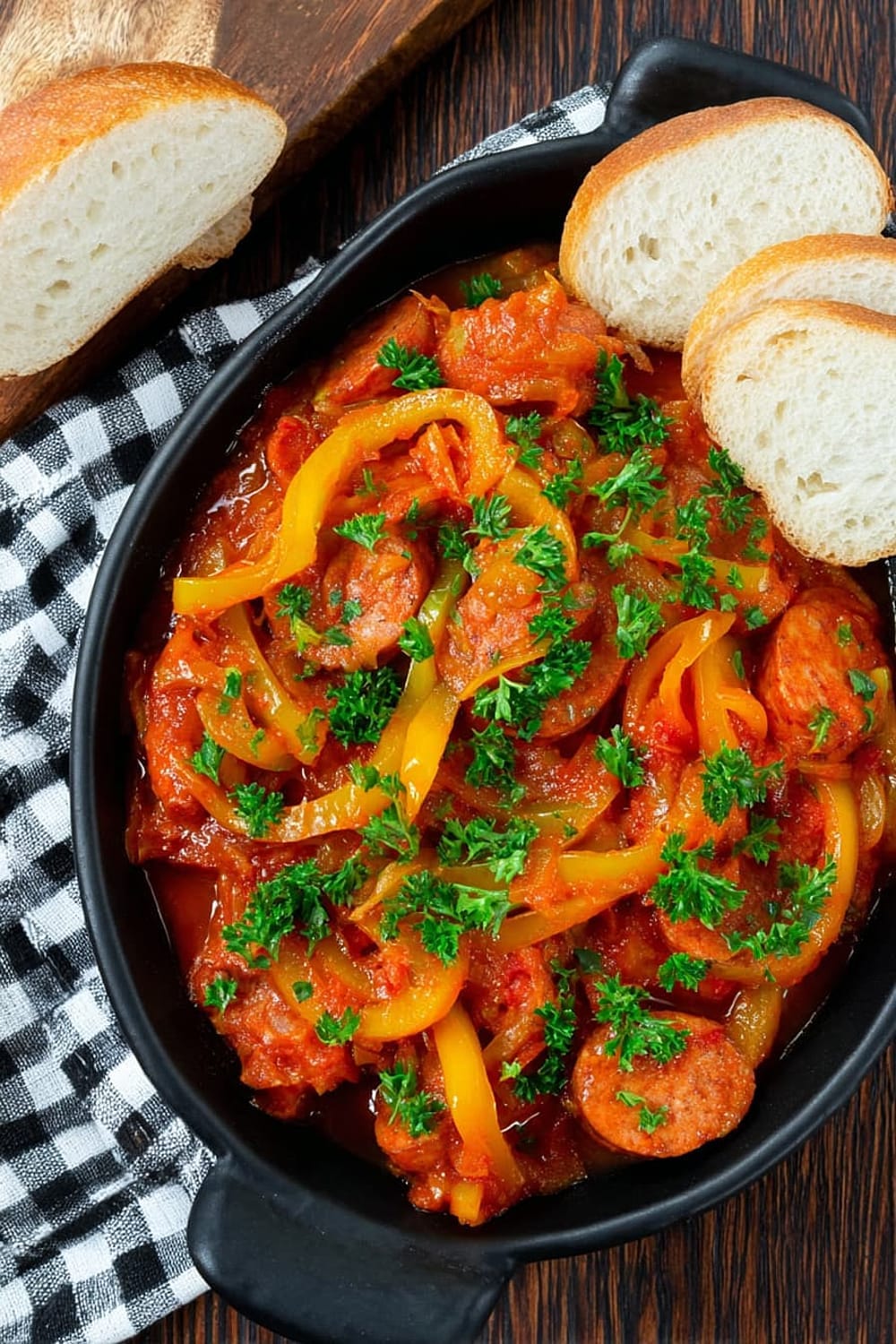
Picture this: smoky bacon and salami sizzling away while sweet peppers and tomatoes bubble into a rich, paprika-scented stew that makes your entire kitchen smell like a cozy Budapest bistro.
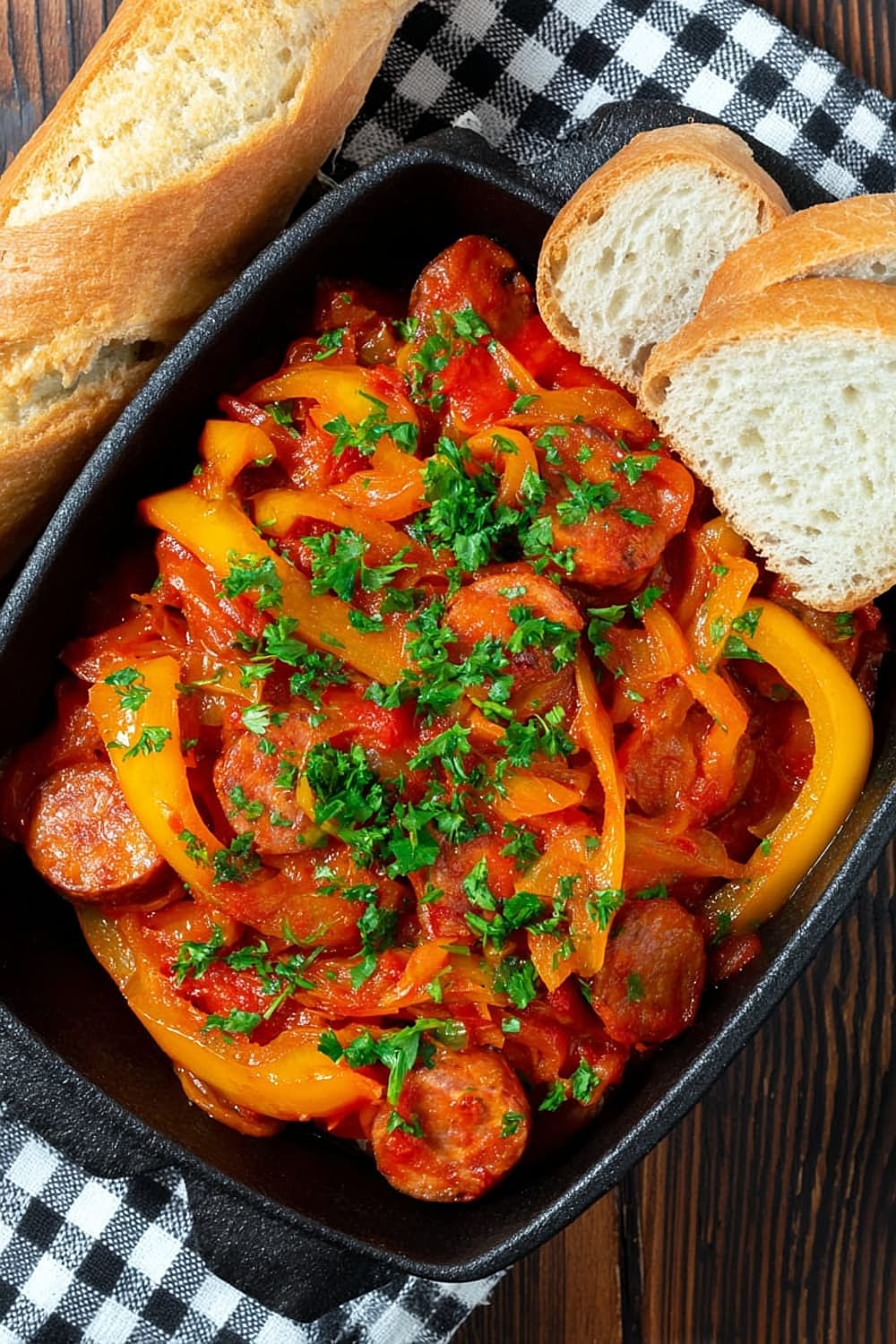
The beauty of lecsó lies in its simplicity – you’re essentially building layers of flavor with just a handful of ingredients, letting each one shine while they meld together into something magical.
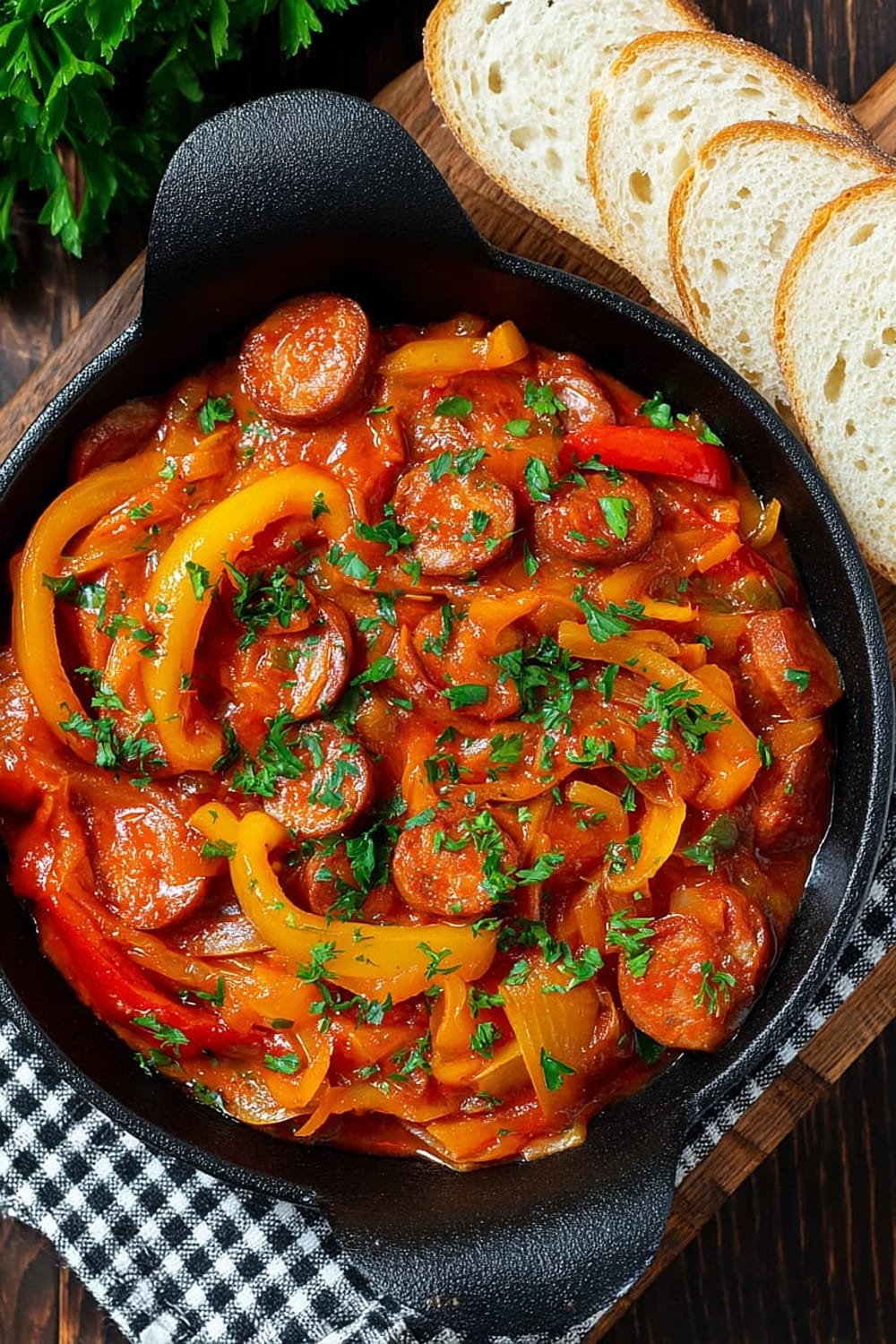
This isn’t your average vegetable stew; the combination of rendered bacon fat, quality salami, and generous amounts of sweet Hungarian paprika creates a depth of flavor that’ll have you scraping the bottom of the pot.
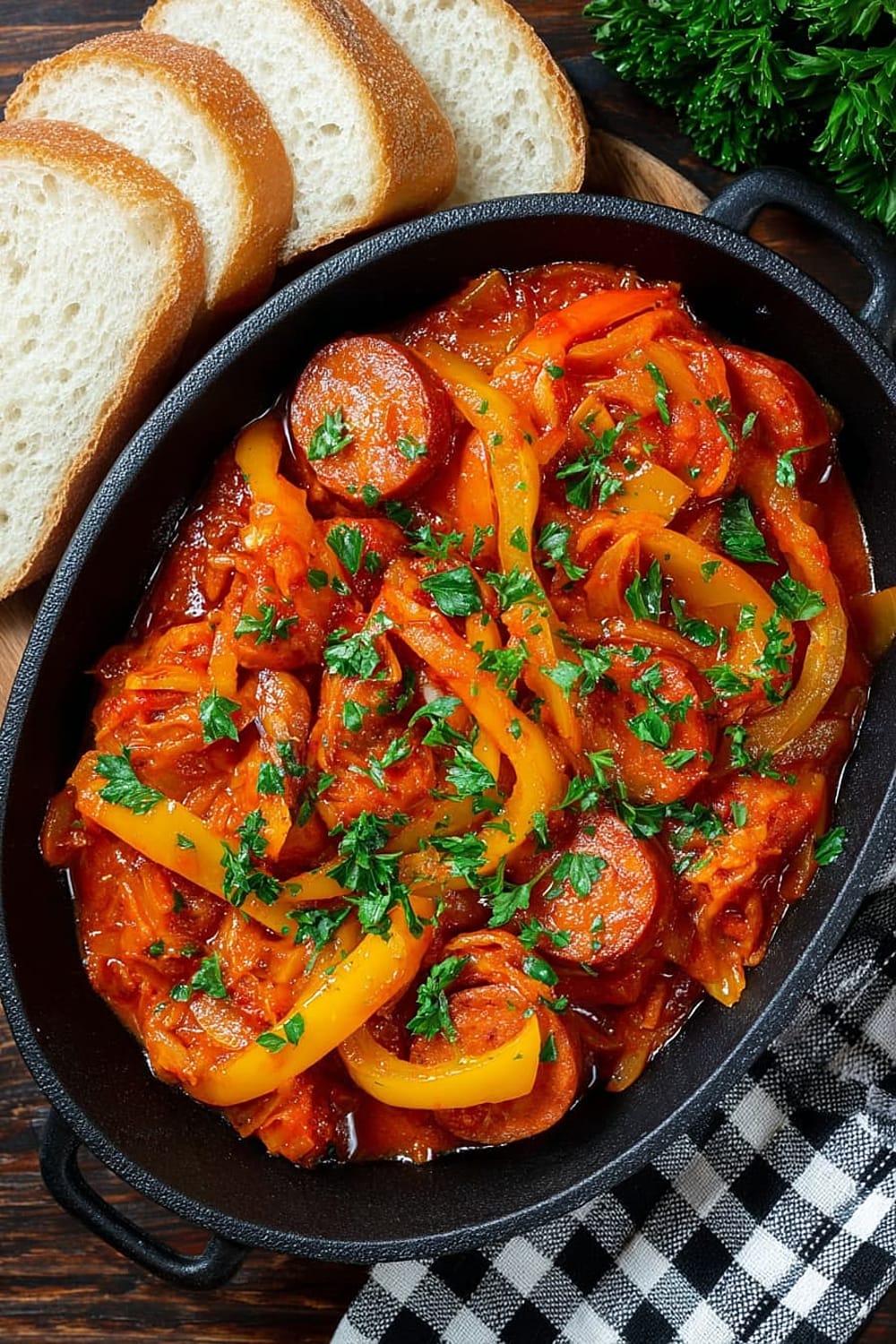
What makes this recipe particularly brilliant is how forgiving it is – you can adjust the vegetables based on what’s in your fridge, and the longer it simmers, the better it gets.

Fair warning: once you master this recipe, you’ll find yourself craving it on every chilly evening, and your friends will start “dropping by” around dinnertime with suspicious frequency.
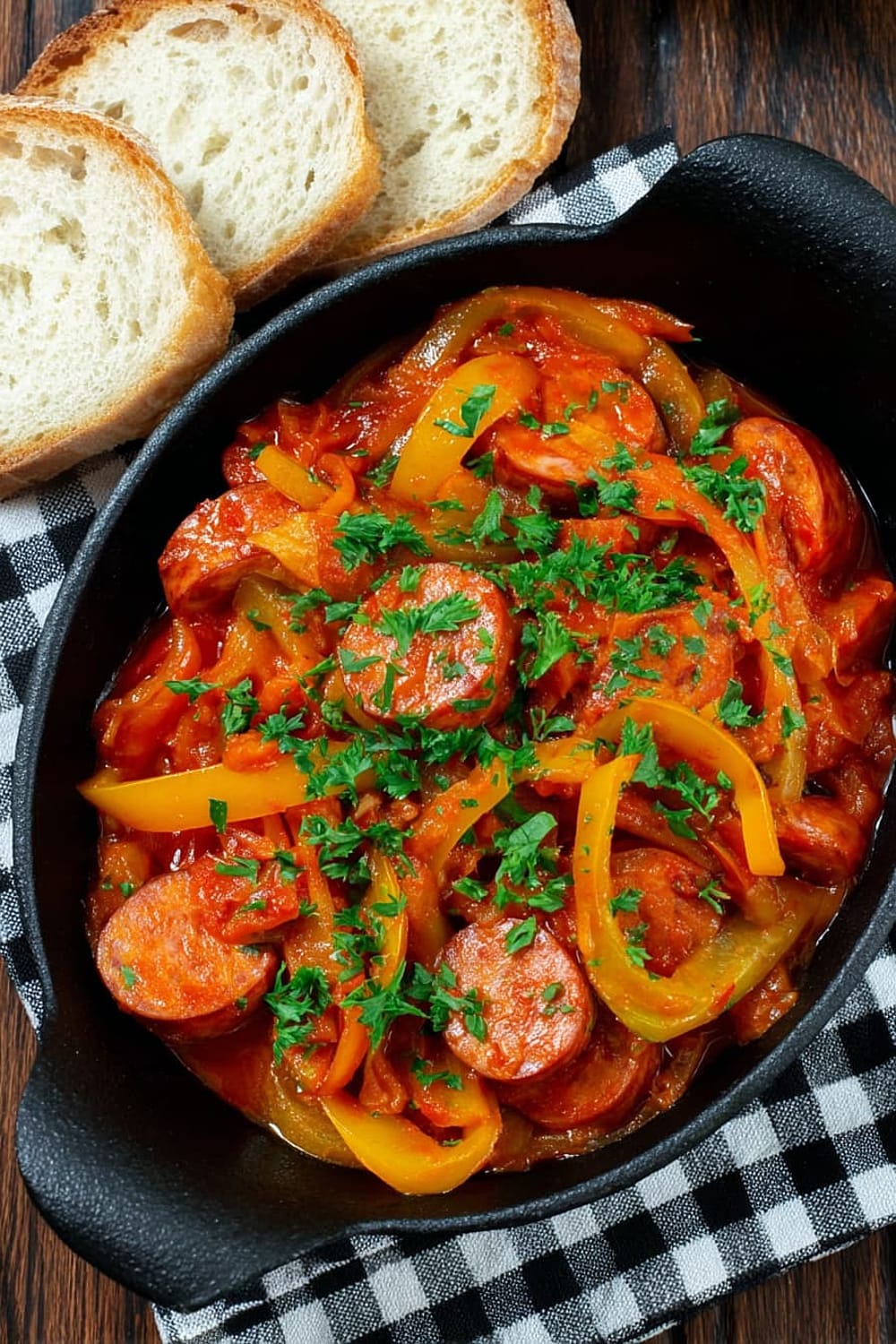
Ingredients
For the Meat Base
- 100 g (3½oz) smoked bacon lardons
- 75 g (2½oz) salami
For the Vegetable Stew
- 4 medium-large (450g total) fresh tomatoes
- 150 g (1 cup) onion
- 2 garlic cloves
- 2 small or 1 large (250g total) yellow pepper
- 2 tablespoons sweet Hungarian paprika
- Salt as needed
Instructions
Prepare the Meat Base
- 1 Heat a 20cm (8-inch) saucepan over medium heat and add the bacon lardons. Cook gently for 10 minutes to start rendering the fat, stirring occasionally. The bacon should release its oils and begin to crisp slightly around the edges.
- 2 While the bacon renders, bring a separate pan of water to a rolling boil. Cut a cross 1-1.5cm (½ inch) deep into the skin at the base of each tomato, then plunge them into the boiling water for 30 seconds. Transfer immediately to a bowl of cold water to stop the cooking process.
- 3 Slice the salami into 3-5mm (⅛-¼ inch) thick coins. After the bacon has rendered for 5 minutes, add the salami coins to the pan and cook for another 5 minutes, stirring occasionally. The salami should release additional oils and develop a slightly crispy exterior.
Prepare the Vegetables
- 4 Cut the onion into a 1-1½cm (½ inch) dice, keeping pieces uniform for even cooking. The size is important – too small and they’ll disappear into the stew, too large and they won’t cook through properly.
- 5 Remove seeds and white pith from the yellow pepper, then cut into 5mm (¼ inch) strips. Consistent sizing ensures even cooking and the best texture in the finished dish.
- 6 Peel the garlic cloves and slice them as finely as possible using a sharp knife or microplane grater. Paper-thin slices will distribute the flavor evenly without creating harsh garlic bites.
- 7 Once the tomatoes are cool enough to handle, peel off the loosened skin and cut each tomato into 8 wedges. The blanching makes peeling effortless and removes any bitter compounds from the skin.
Build the Stew
- 8 Add the diced onion to the pan with the rendered meat and cook for 5 minutes, stirring regularly. The onions should become translucent and start to caramelize slightly in the flavorful fat.
- 9 Add the sliced garlic and cook until fragrant, which takes 30-60 seconds. Don’t let the garlic brown or it will become bitter and overpower the delicate balance of flavors.
- 10 Add the yellow pepper strips, tomato wedges, and sweet Hungarian paprika to the pan. Give everything a thorough stir to coat with the rendered fat and distribute the paprika evenly. Reduce heat to medium-low and simmer for 25 minutes or until you have a thick, rich stew. After 5 minutes of simmering, taste and add salt if needed – the bacon and salami may provide enough saltiness on their own.
Recommended Equipment and Kitchen Tools
Essential Tools (for best results)
- Heavy-bottomed saucepan – A quality 20cm (8-inch) saucepan with thick bottom prevents scorching and ensures even heat distribution during the long simmer
- Sharp chef’s knife – Critical for achieving uniform vegetable cuts that cook evenly and look professional in the finished dish
- Cutting board – A large, stable wooden cutting board provides ample space for prep work and protects your knife edge
- Wooden spoon – Won’t scratch your pan and allows you to scrape up the flavorful fond that develops during cooking
Helpful Upgrades
- Kitchen scale – Measuring ingredients by weight ensures consistent results, especially important for the meat-to-vegetable ratio in this recipe
- Microplane grater – Creates perfectly fine garlic slices that distribute evenly throughout the stew without creating harsh bites
- Instant-read thermometer – While not essential, helps ensure your stew reaches the optimal 165°F (74°C) internal temperature for food safety
Nice-to-Have Options
- Cast iron Dutch oven – Provides superior heat retention and can go from stovetop to oven if you want to finish the dish with a brief broil
- Silicone spatula – Perfect for scraping every last bit of this delicious stew from the pan for serving
Recipe Variations and Dietary Modifications
Traditional Hungarian Variations
- Lecsó with eggs – Crack 2-3 eggs directly into the finished stew during the last 3 minutes of cooking, stirring gently to create ribbons
- Vegetarian lecsó – Omit bacon and salami, increase paprika to 3 tablespoons, and add 2 tablespoons olive oil for richness
- Spicy version – Add 1 teaspoon hot Hungarian paprika along with the sweet paprika for authentic heat
- Sausage variation – Replace salami with 150g Hungarian kolbász or kielbasa, sliced into coins
Seasonal Modifications
- Summer abundance – Add 1 medium zucchini (diced) and 1 small eggplant (cubed) during the last 15 minutes of cooking
- Winter heartiness – Stir in 200g cooked white beans during the final 5 minutes for extra protein and substance
- Garden fresh – Use a mix of colored bell peppers (red, yellow, orange) for visual appeal and slightly different flavor notes
Dietary Adaptations
- Lower sodium – Use nitrate-free bacon and reduce or omit added salt, relying on the natural flavors of the vegetables
- Gluten-free – Naturally gluten-free as written, but check salami labels to ensure no wheat fillers are used
- Dairy-free – Recipe is naturally dairy-free, making it suitable for lactose-intolerant diners
Nutritional Information and Health Benefits
Key Nutritional Highlights
This hearty Hungarian stew provides approximately 280-320 calories per serving (recipe serves 4), with a balanced macronutrient profile featuring 18g protein, 12g fat, and 15g carbohydrates. The combination of meat and vegetables creates a satisfying meal that provides sustained energy without excessive calories.
Health Benefits of Main Ingredients
Bell peppers are nutritional powerhouses, containing more vitamin C than oranges – a single serving of this lecsó provides over 100% of your daily vitamin C needs. The tomatoes contribute significant amounts of lycopene, a powerful antioxidant that becomes more bioavailable when cooked, making this stew actually more nutritious than raw tomato dishes. Hungarian paprika isn’t just for flavor – it contains capsaicin and carotenoids that support metabolism and eye health. The onions and garlic provide quercetin and allicin, compounds known for their anti-inflammatory and immune-supporting properties.
Dietary Considerations
This recipe is naturally gluten-free and dairy-free, making it suitable for many dietary restrictions. The high vegetable content provides 6-8g fiber per serving, supporting digestive health. The moderate protein content from bacon and salami makes this suitable for most eating plans, though those watching sodium should be mindful of the cured meat content.
Smart Swaps and Ingredient Substitutions
Common Substitutions:
- Bacon lardons → Pancetta (same amount) or thick-cut bacon, diced, for similar flavor and fat content
- Salami → Chorizo or kielbasa for different but complementary smoky flavors
- Yellow peppers → Red bell peppers or a mix of colors for visual variety and slightly sweeter flavor
- Sweet Hungarian paprika → Spanish smoked paprika (use 1½ tablespoons) for a different but authentic flavor profile
Budget-Friendly Swaps:
- Fresh tomatoes → 1 can (400g) whole tomatoes, drained and chopped, especially practical in winter months
- Quality salami → Summer sausage or turkey pepperoni for similar texture at lower cost
- Bacon lardons → Regular bacon, chopped, or even bacon bits if budget is tight
Pantry Emergency Substitutions:
- Fresh garlic → 1 teaspoon garlic powder (add with paprika to prevent burning)
- Fresh onion → 2 tablespoons dried minced onion, rehydrated in warm water for 10 minutes
- Hungarian paprika → Regular paprika plus ½ teaspoon smoked paprika for complexity
Pro Tips for Substitutions:
- Store Hungarian paprika in the refrigerator to maintain its vibrant color and prevent bitter flavors
- When using canned tomatoes, add them 5 minutes later than fresh to prevent overcooking
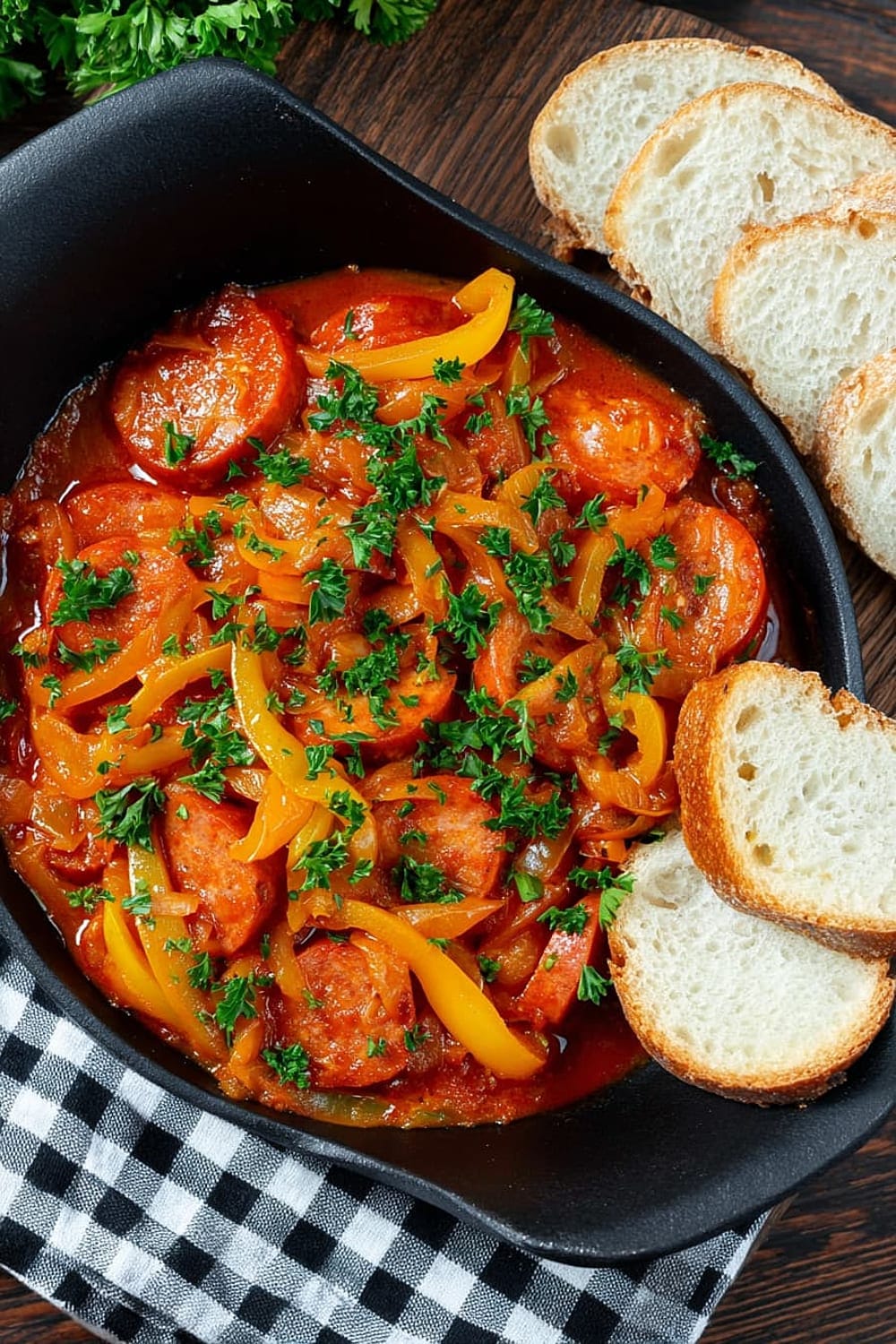
Make It Diabetes-Friendly
Carbohydrate Management:
- Original carbs per serving: Approximately 15g from natural vegetable sugars
- Portion control: Serve ¾ cup portions alongside lean protein or over cauliflower rice instead of traditional bread or potatoes
- Fiber boost: Add 1 cup diced zucchini during the last 10 minutes of cooking to increase fiber content to 8-9g per serving
Blood Sugar Optimization:
- Protein pairing: Serve with 2-3oz additional lean protein like grilled chicken or fish to slow glucose absorption
- Healthy fat addition: Drizzle with 1 teaspoon extra virgin olive oil before serving to further moderate blood sugar response
- Timing strategy: This recipe works excellently as a lunch option when blood sugar control is typically easier to manage
Smart Modifications:
- Reduce bacon to 50g and add 100g lean ground turkey for lower saturated fat content
- Increase vegetables: Add 1 cup diced eggplant and ½ cup diced zucchini for more volume with minimal carb increase
- Herb enhancement: Fresh basil and oregano add flavor without affecting blood sugar
Total Carb Reduction: These modifications reduce net carbs to approximately 10-12g per serving while increasing fiber and protein content.
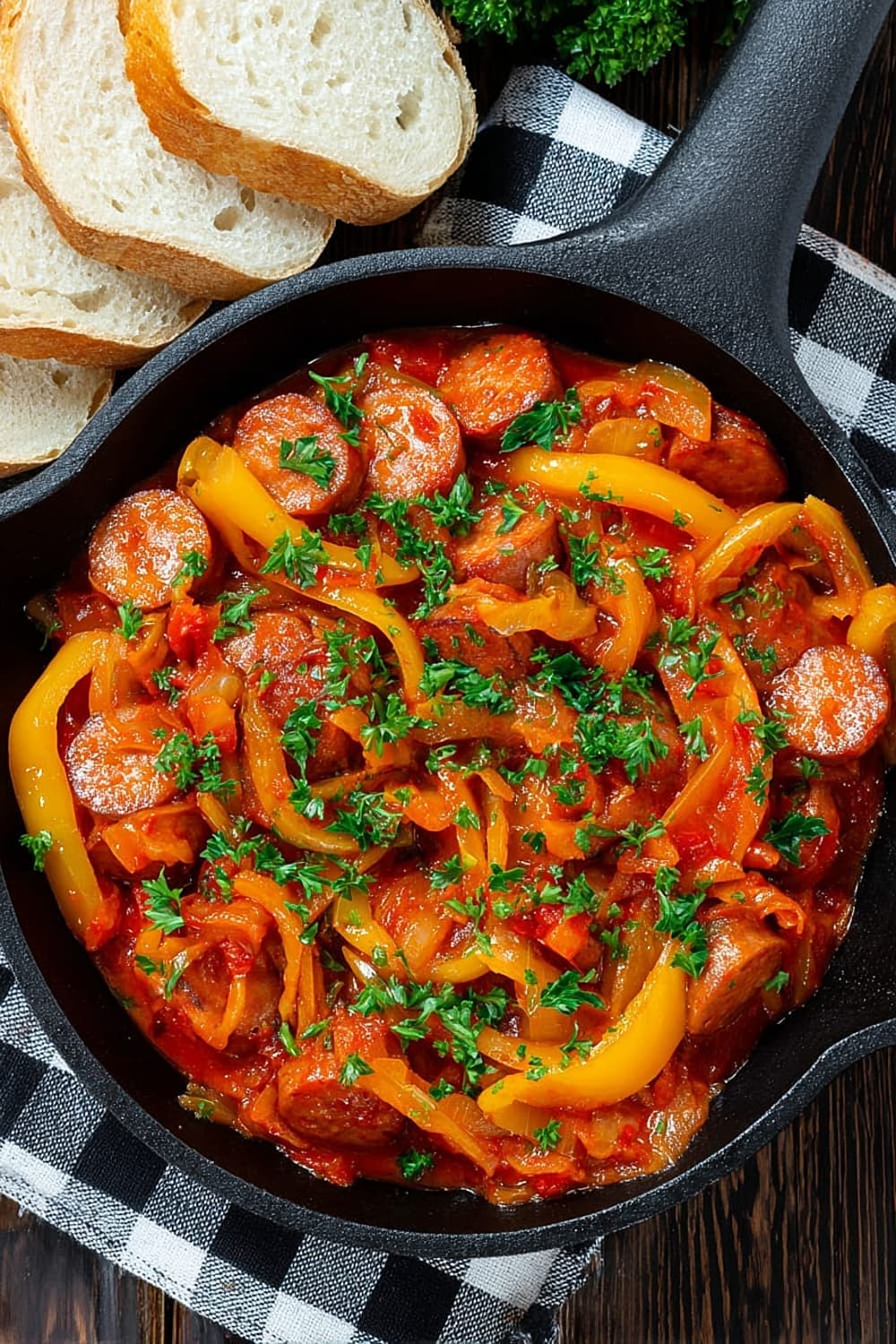
Perfect Pairing Suggestions
Beverage Pairings
A medium-bodied Hungarian red wine like Egri Bikavér (Bull’s Blood) complements the paprika and meat flavors beautifully, while a crisp Riesling provides a refreshing contrast to the rich, smoky elements. For beer lovers, a Czech pilsner or German wheat beer cuts through the richness perfectly. Non-alcoholic options include sparkling water with lemon or unsweetened iced tea to cleanse the palate between bites.
Side Dish Recommendations
Traditional Hungarian egg noodles or spaetzle make authentic accompaniments that soak up the flavorful juices. For a lighter option, serve over cauliflower rice or alongside crusty sourdough bread for dipping. A simple cucumber salad with vinegar dressing provides cooling contrast, while roasted root vegetables add earthy complexity that complements the peppers and tomatoes.
Complete Meal Ideas
Start with a light mixed greens salad with lemon vinaigrette to prepare the palate. The lecsó serves as an excellent main course, followed by Hungarian apple strudel or simply fresh fruit for dessert. For entertaining, this recipe doubles easily and pairs wonderfully with Hungarian goulash for a themed dinner party.
Occasion Suggestions
Perfect for casual weeknight dinners, cozy weekend meals, or outdoor gatherings where you want something hearty but not overly heavy. The recipe scales beautifully for holiday buffets and makes an excellent potluck contribution that travels well.
Pro Tips and Troubleshooting
Professional Techniques
The key to authentic lecsó lies in proper fat rendering – don’t rush the initial bacon cooking phase, as this creates the flavorful base for the entire dish. Layer your vegetables in order of cooking time: onions first to develop sweetness, then garlic briefly to release aromatics, and finally peppers and tomatoes together. Taste and adjust seasoning after the first 5 minutes of simmering, as the salt content can vary significantly depending on your bacon and salami.
Common Mistakes and Solutions
Watery stew results from not cooking long enough – continue simmering uncovered until the liquid reduces to a thick, chunky consistency. Bitter flavors usually indicate burnt garlic or paprika; add these ingredients off the heat or at reduced temperature. Uneven vegetable texture comes from inconsistent cutting – take time to dice everything uniformly for professional results.
Storage and Reheating
Lecsó actually improves overnight as flavors meld. Store covered in the refrigerator for up to 4 days or freeze for 3 months. Reheat gently over low heat, adding a splash of water if needed to prevent sticking. The dish reheats beautifully in the microwave at 50% power in 1-minute intervals, stirring between.
Make-Ahead Strategies
Prep all vegetables the morning of cooking and store covered in the refrigerator. The completed dish can be made 2 days ahead and actually tastes better after resting. For meal prep, portion into individual containers and reheat as needed throughout the week.
This Hungarian lecsó represents comfort food at its finest – simple ingredients transformed through proper technique into something that feels like a warm hug from your Hungarian grandmother, even if you don’t have one. The beauty lies not just in its rustic, homestyle appeal, but in how it brings people together around the table, sharing stories over steaming bowls of this aromatic, soul-warming stew that tastes like it took all day to make.